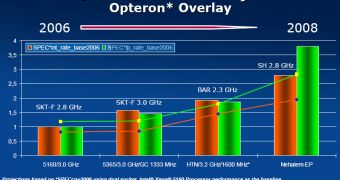Server manufacturer Sun Microsystems has involuntarily posted on its website classified information regarding its upcoming server platforms built on Xeon Dunnington and Nehalem architectures. More to the point, the slides Intel handed Sun back at the International Solid-State Semiconductor Conference ended up on Sun's website.
The Nehalem architecture has been widely dissected and there's nothing really much left under the veil, but the almost secret Xeon Dunnington is quite a piece. Dunnington is the codename for Intel's new 45-nanometer six-core Xeon processor in the Penryn family, that will replace the Xeon Tigerton CPUs. The Tigerton is comprised of two 65nm Core 2 Duo processors that share the same package, but the new Xeon descendant will be the company's first processor in the Core 2 Duo family to be built with three dual-core banks.
The Dunnington features a pool of 16MB of L3 cache that will be shared among all the 6 processing cores. Moreover, each pair of cores will have access to a local L2 cache pool of 3MB. The Dunnington is somewhat similar in terms of design with AMD's Barcelona quad-core design, yet it is much improved, given the fact that AMD's CPUs come with 512KB of L2 cache per core. The Dunningtons will inherit the same socket design as the older Tigertons, while preserving their pin-to-pin compatibility. One of the slides reveal that the CPU will kick in during the third quarter of 2008.
The second "bomb" from Intel is the Nehalem architecture, that comes with every feature implemented in Penryns, such as hafnium-infused transistors, metal gate, the 45-nanometer processing node, quad-core architecture and the new SSE4 instruction set. The manufacturer will send the old FSB technology to the recycle bin, and will adopt the more efficient Quick Path Interconnect.
The upcoming Nehalems will double the computing performance of the existing Penryn-based processors. Its power will be also boosted by the fact that the chips will come with on-die memory controllers, a novelty in over 18 years from Intel.

 14 DAY TRIAL //
14 DAY TRIAL //